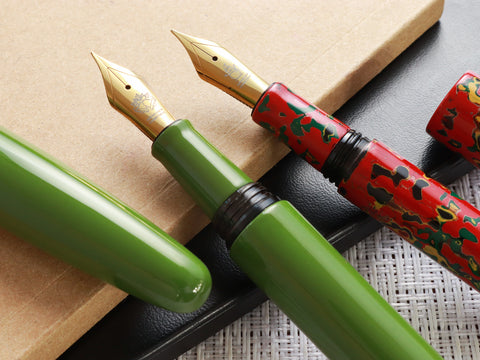In the world of fountain pens, aficionados understand the profound impact that nibs have on the writing experience. While we can all appreciate the fountain pen’s designs, there would be no fountain pen without nibs. Historically, fountain pen nibs used to be made-to-order by the fountain pen makers themselves, but as the use of fountain pens became more widespread across the world, a standardization became necessary. This led to the creation of Fine (F), Extra Fine (EF), and other nib ‘sizes.’
Despite the standardization of nib sizes, however, it soon became clear to the users of fountain pens that there appeared to be a difference between the nib sizes of Japan and a Western country like Germany.
Before diving into the differences, it’s important to note that there will always be exceptions to the norm, and that there will be certain generalizations throughout this analysis. However, this doesn’t mean that Western nibs or Japanese nibs are inherently better than their counterpart, nor does it mean that every single Japanese nib is the same.
To simplify the comparison, we will be comparing Japanese nibs and German nibs, as nibs produced in Germany are the most popular nibs produced in the West. However, that doesn't mean that the nibs from the US, the UK, or any other country in the West are inferior or not worth discussing. If you are interested in learning about the subtle nuances between these Western nibs, please leave a note below in the comments.
JAPANESE NIBS
Japanese fountain pen nibs are renowned for their precision and delicacy. Crafted with meticulous attention to detail, Japanese nibs often exhibit finer points and softer flex, allowing for graceful and expressive writing. The artistry of Japanese nib making dates back centuries, rooted in a tradition that values subtlety and refinement.
One notable characteristic of Japanese nibs is their tendency to produce finer lines compared to their German counterparts. This fine line width makes Japanese nibs particularly well-suited for intricate calligraphy and precise lettering, appealing to those who prioritize intricate detail in their writing.
Moreover, Japanese nibs often offer a smoother, more consistent ink flow, contributing to a seamless writing experience that feels effortless on paper. This consistency is achieved through meticulous craftsmanship and rigorous quality control, reflecting the Japanese commitment to excellence in all aspects of design and production.
GERMAN NIBS
In contrast, German fountain pen nibs are celebrated for their durability and robustness. German nib makers prioritize functionality and reliability, crafting nibs that can withstand extended use without compromising on performance. This emphasis on durability has made German nibs a popular choice among writers who seek a dependable tool for everyday use.
German nibs typically exhibit a slightly broader line width compared to Japanese nibs, offering a bolder stroke that enhances readability and presence on the page. This broader line width can be particularly appealing for those who prefer a more assertive writing style or need their writing to stand out clearly, such as when taking notes or signing documents.
Additionally, German nibs are often characterized by a firmer feel and less flex compared to Japanese nibs. While this may result in a slightly less expressive writing experience, it also provides a sense of control and stability that some writers prefer, especially when writing for extended periods.
****
In the world of fountain pens, the choice between Japanese and German nibs is not simply a matter of preference but a reflection of one's individual writing style and aesthetic preferences. Whether you gravitate towards the delicate precision of Japanese nibs or the robust functionality of German nibs, both traditions offer a rich tapestry of craftsmanship and innovation for fountain pen enthusiasts to explore and appreciate.
Furthermore, one of the main benefits of using a fountain pen instead of a ballpoint pen is your ability to easily change nibs. Depending on your mood, you could use a Matama Semi-Flex nib made in Japan with a distinctly Western pen, or you could use a Jowo #6 nib with an authentic Urushi fountain pen.
Ultimately, the beauty of fountain pens lies in their ability to transform the act of writing into a deeply personal and satisfying experience, regardless of the nib style chosen.






1 comment
Fantastic post. I would be interested to know more about Italian nips. Besides the Japanese tradition (I own many pens: Sailor, Platinum, Pilot et.al.) and German pens (nips) which are to unfeasible for my taste, I am also very fond of Aurora pens.
One more question: do you do the Kodachi modification also with 21k Gold nips? And: are they more like Naginata Togi nips or more like architects nips?